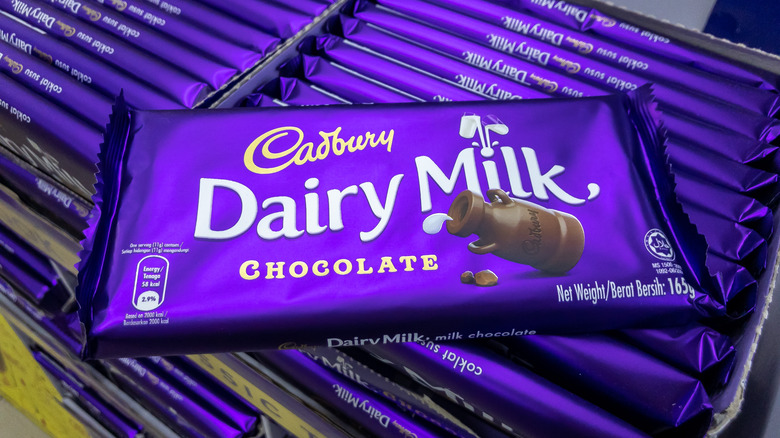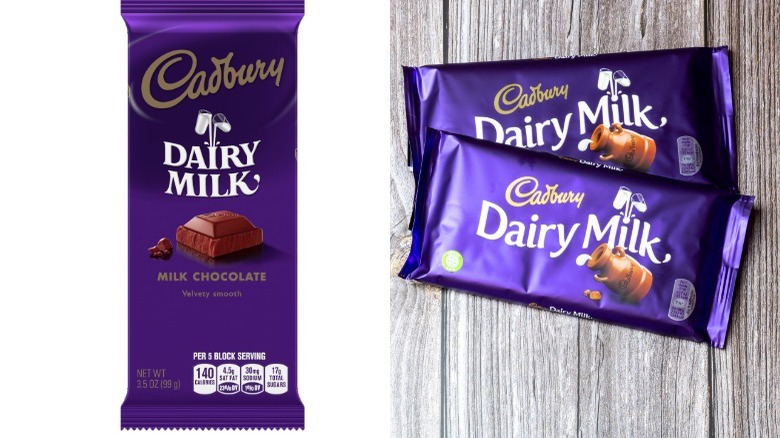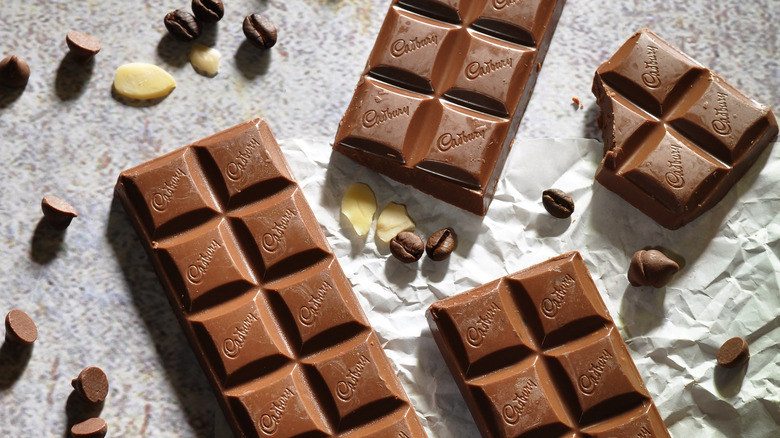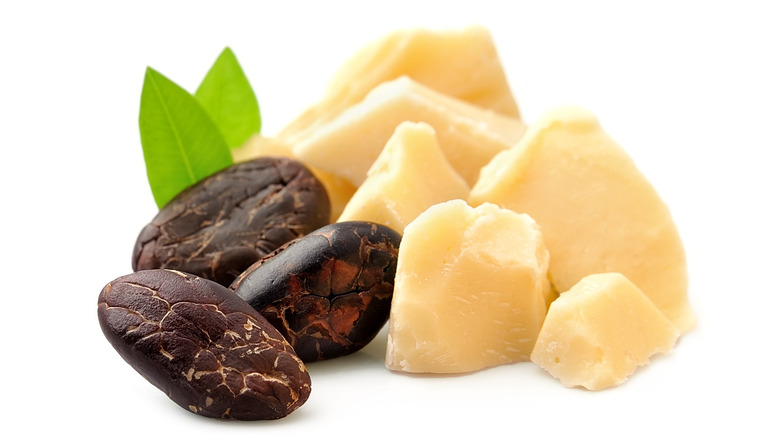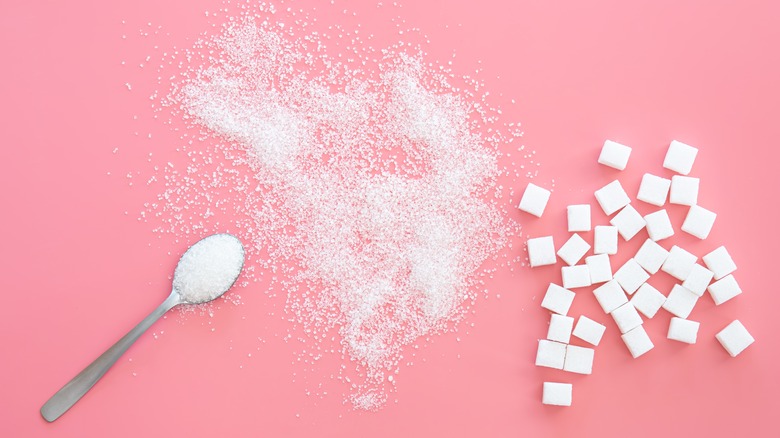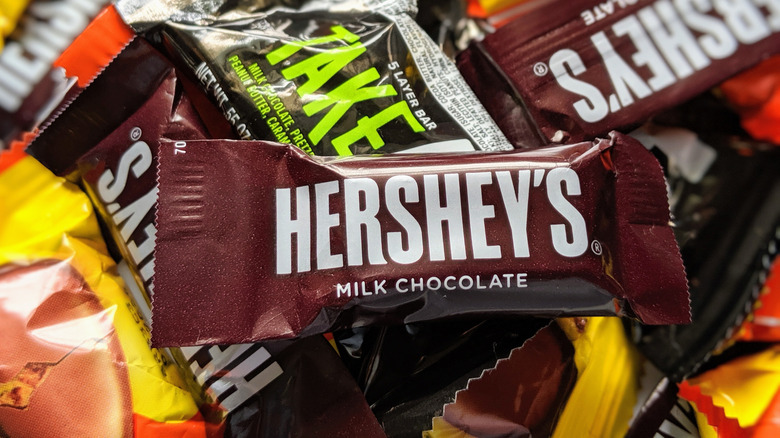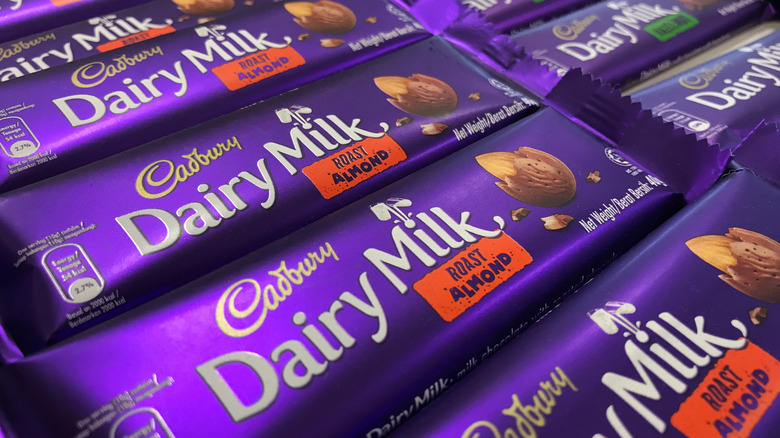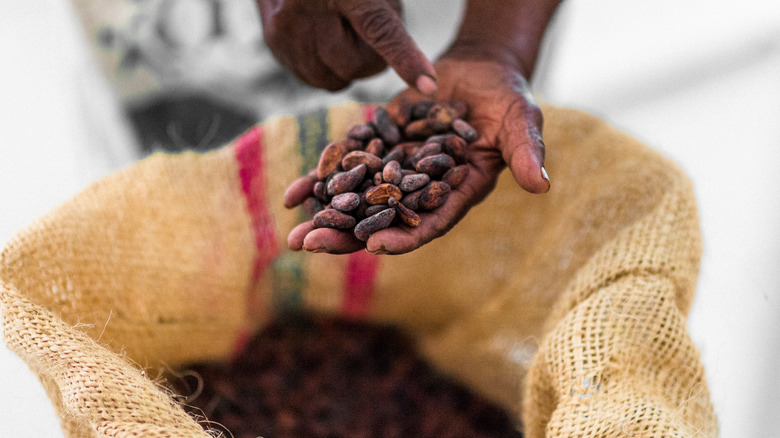10 Ways British And American Cadbury Chocolate Is Different
Cadbury chocolate has a long and distinguished history of delighting the taste buds of children and adults alike. The company was founded by John Cadbury in 1824, the namesake of the company, in Birmingham, England. At that time, Cadbury was simply a shop that sold tea and coffee in addition to chocolate. The specialty, though, was hot chocolate, which John Cadbury ground himself before serving to delighted customers.
The shop's hot chocolate took off, and by 1831, John Cadbury had opened his first factory. While the company's hot chocolate is undoubtedly still popular today, you may know about its chocolate bars, the way most of us consume Cadbury. Those did not show up until 1847, when J. S. Fry & Sons created the first version of a chocolate bar. Cadbury's first milk chocolate bar did not come on the market until 1897, and it was not until 1905 that the Cadbury Dairy Milk chocolate bar finally arrived on the market.
Now more than 100 years later, Cadbury Dairy Milk is still one of the company's most popular brands. However, as the company has expanded across the globe, fans have noticed some discrepancies between the Cadbury from the company's home territory and the Cadbury that is available across the pond in the United States. So we did some digging to find out what the differences truly are.
1. The Packaging
One of the first differences most people will notice is in its packaging. Both Dairy Milk chocolate bars' packages feature Cadbury Dairy Milk's signature deep purple color and the swirling gold Cadbury font. But this is about where the similarities end.
One of the most significant stylistic differences between the two is the direction in which the imagery goes. An American Cadbury Chocolate bar needs to be held vertically in order to read the information on the package, whereas the British Cadbury bar is positioned horizontally. Next, the font utilized for most of the rest of the packaging is different.The United States packaging features a serifed font for "dairy milk," whereas the British one uses a sans serif font. In addition, the image of the chocolate is completely different on each, which we will discuss further on. Some of the British bars even feature an old-fashioned milk container made of chocolate.
The biggest change, though, is the information on the package. While the front of the United States package includes nutritional information and the phrase "velvety smooth," the British packaging announces, "the classic creamy taste." Could this difference in phrasing allude to a difference in taste? It certainly seems so.
2. The Shape
Once you open both the English and American Cadbury bars, you see that the visual differences do not end there. The two confections offer completely different shapes for the chocolate.
Each rectangular bar of chocolate is broken down into pieces of molded chocolate that are easy to break off the whole bar. For example, the British version of the bar is broken down into rectangular-shaped pieces. These pieces are also heavily domed to create a taller appearance with more variation between high and low peaks. The United States bar, on the other hand, is square, and while it has a bit of a raised platform caused by the grooves in the chocolate, it is a predominantly flat top.
Both bars of "Cadbury" have the company molded into each individual piece in their signature font. But it is clear just from looking at them that there is more to the differences than meets the eye.
3. The Type of Added Fat
It is unsurprising, then, that once you bite into a piece of Cadbury chocolate, the inside is just as different as the outside. Looking at the ingredient lists of the two bars, there are some notable fundamental differences. The United States bar includes just one kind of fat, cocoa butter. The British version includes vegetable fats from palm and shea in addition to cocoa butter. It should be noted that the countries in which the bars are sold play a part in this difference. In the United States, cocoa butter has to be used to follow FDA standards to be considered milk chocolate. In the United Kingdom, other fats are allowed to be included. The addition of these fats helps to give the bars a richer and smoother texture.
Not only is it the type of fat that is different, but there is more fat in the United Kingdom Cadbury. Per 100 grams of chocolate, a United States bar has 27.5 grams of fat, and a United Kingdom bar has 30. It may not seem like much, but this could be enough to cause some taste differences.
4. The Sugar and Nutritional Content
The ingredient and nutrition differences do not stop there. A United Kingdom bar has slightly more calories than a United States bar, coming in at 534 calories per 100 grams versus 500 for the United States version. The order of ingredients is also different, with the United Kingdom Cadbury starting with milk as the first ingredient and the United States Cadbury variety starting with sugar. Some have even claimed the United States one tastes sweeter, though the final sugar content is about the same.
What is interesting, though, is that Hershey's, the company that produces Cadbury in the United States, claims that despite this clear difference, the chocolate is still functionally the same. A representative for the company insisted to Business Insider that the essential ingredients come from Cadbury in the United Kingdom and that any differences are due to "labeling standards" in the countries. However, we are not buying it, given the nutritional differences and the comments on taste from those who have tried both.
5. The Texture
While many of the taste and texture notes can be debated depending on the chocolate connoisseur who holds them, there are some consistently noted differences between the two bars. Perhaps the biggest difference is the texture. Taste test after taste test has shown that the United Kingdom bar has a more silkier and smoother texture than the United States Version.
A taste test from The New York Times described the United Kingdom bar as "creamier." This was mirrored by a Business Insider taste test which found the United States bar to be downright crumbly. The textural and taste difference was so pronounced that a blind taste tester was instantly able to tell the difference and knew which bar was which.
While the company does claim that most of the ingredients are the same, the additional fat in the United Kingdom bar, as well as the types of fat used, could be the source of this textural difference. Additionally, since the bars are made in different facilities, there could be a variance in the processing that accounts for the United Kingdom bar gaining its smooth texture. The irony here is that the American Cadbury bar is the one that touts its "velvety smooth" texture.
6. Who Makes It
The biggest difference between the two brands, though, boils down to one simple thing: who makes them. It may be easy to assume that since the bars are labeled Cadbury that Cadbury makes all the chocolate and simply sells it in a slightly different version. The truth, however, is far more complicated.
Parent company Mondelez still produces Cadbury in England. However, in the United States, Cadbury is actually produced by the Hershey's chocolate company. In 1988 Cadbury sold the brand rights, as well as two United States factories, to Hershey's. The Guardian reported that this was an attempt to prevent a total takeover. In addition to Cadbury Dairy Milk, Hershey's acquired the rights to other products such as Mounds and Peppermint Patties. However, this was just the beginning.
While the rights did give Hershey's the ability to use the name, and a company spokesperson says they get most of the raw ingredients from Cadbury United Kingdom, it appears the company is not required to use the exact same recipe. In addition, the precise wording of the contract is not currently known and may give Hershey's some pretty broad use of the name.
7. Where It Can Be Sold
These distribution rights are just the tip of the iceberg, though. With such noticeable taste differences, it is only understandable that some people in the United States wanted to get their hands on the British version of the bar. However, thanks to a lawsuit brought by Hershey's in 2015, acquiring Cadbury's English-made chocolate in the United States became increasingly difficult.
Hershey's sued Let's Buy British Imports, claiming that by importing the British version of the product, they were confusing customers and infringing on trademark law. They also sued another importer, Posh Nosh, for the same thing and won. As a result, Let's Buy British Imports settled with Hershey's and agreed to stop an important number of chocolates, including Cadbury.
Understandably, this did not sit well with many British expats in America or even those who simply enjoyed the product. When this all went down, smaller importers such as Nicky Perry, owner of Tea&Sympathy in Greenwich Village, New York, fought back. After vocally denouncing the scare tactics Hershey's used, stock in Hershey dropped, and importers were once again able to source their preferred chocolate.
8. What Products it Has
One of the other notable differences extends beyond the dairy milk bar. While that is the product that is easiest to compare side to side and tell the differences, the products that Cadbury United States and Cadbury United Kingdom produce are just flat-out different a lot of the time.
Both do chocolate bars and the famous Cadbury Creme egg. Cadbury United States also has the right to Cadbury Caramello. However, Cadbury United States has taken that Cadbury name and applied it to flavored bars that simply do not exist in the British line, such as Dairy Milk Roasted Almond, Black Forest, and Rock the Road, the latter being a play on the rocky road ice cream flavor.
Cadbury United Kingdom, for its part, also offers a wide selection of candy not made by the United States producer. This includes, but is not limited to, 30% less sugar, white chocolate, Choca-Latte, Oreo, and Twirl Orange. Each company has its own line that seems suited to the taste buds of the region they sell in. But it should be noted that the Cadbury United Kingdom has a much larger selection than that of its Hershey's-produced counterpart.
9. Sustainable Cocoa
One thing we could not help but notice between the two bars is that the Cadbury United Kingdom bars each contain a certification for Cocoa Life. Cocoa Life was started in 2012 by Mondelez International, the company that now owns Cadbury UK. Cocoa Life's goal is to provide community support for the cocoa producers in each country the company works with and source sustainable cocoa from them. Unfortunately, the chocolate industry is notoriously inequitable and exploitative of both the labor and earth behind one of our favorite treats. At this point, Cadbury Dairy Milk, made in the UK, receives a Cocoa Life badge on the label, and the company hopes that by 2025 all the Cadbury Products will have it.
It is notable that despite Hershey's stating they get their chocolate from Cadbury United Kingdom, it does not include this label. Hershey's has its own sustainability program, Cocoa for Good, which seeks to work on nutrition, at-risk youth, and ecosystems built around cocoa.
10. How People Feel About It
Finally, the biggest difference seems to be in how people feel about these chocolates. For all the perceived differences in taste, there is one thing that stays pretty consistent: people generally prefer the British version to the American version. Business Insider did a taste test with Americans and found that while one could not taste the difference, one preferred the American version, and two preferred the British one. In a follow-up article, two British expats had differing views on which was sweeter, but both preferred the British one.
Nicky Perry literally launched a whole campaign tanking a company's stock prices and reputation just so she would not have to carry Hershey's version of the chocolate. It is notable both that there is a large import of British Cadbury in the United States, whereas not much, if any, has been written about the import of American Cadbury to England. It is telling that Hershey's felt the need to sue importers to try and stop consumers who might choose British over American Cadbury. Overall, people clearly have strong opinions on how they feel about Cadbury.
